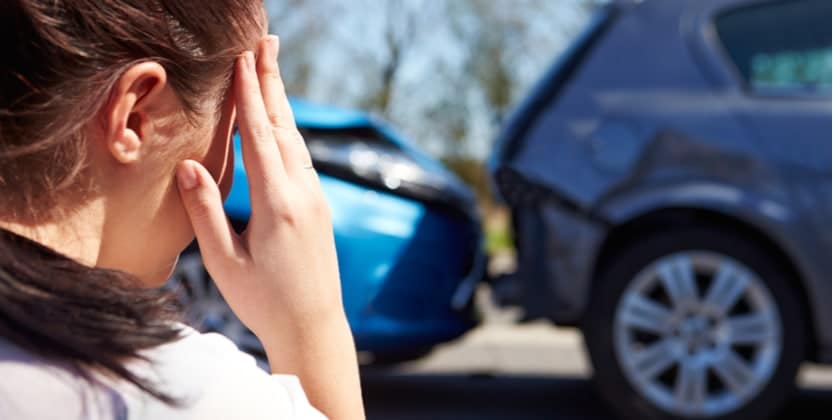Florida is an extremely large and spread-out state, so it is probably no surprise to anyone that the vast majority of our population uses automobiles as their main mode of transportation every single day.
While driving through the palm tree-lined roads and sunny streets of Florida may be your daily routine, knowing the roads does not make your daily commute any less hazardous. According to the department of Florida Highway Safety and Motor Vehicles, there were 400,487 auto accidents in 2019, leading to 254,358 injuries and 3,220 fatalities among motorists, pedestrians, and cyclists. A whopping 33.10% (132,578) of those accidents occurred in the areas of Florida we serve, with a mere 2.42% (9,680) in the Treasure Coast.

The different injuries resulting from an automobile accident are as varied as the individual circumstances of each collision, but there are some types of injuries that are much more common than others. Let’s take a look through the most prevalent types of injuries that occur as a result of automobile accidents.
Head and Brain Injuries
Head injuries are a common result of car crashes, due to the car’s unexpected stop or change in direction. Not only can this cause muscle strains in the neck and back, but the head, and more importantly the brain, can be injured.
A blow to the head or piercing head injury can damage the brain, causing a traumatic brain injury. Brain injuries can be relatively mild, such as a concussion that heals on its own after a week’s rest. On the other hand, a brain injury can be so severe that it impairs critical functions such as speech, vision, concentration, memory, emotional and physical control.
Signs that you may have suffered a head injury can include:
- Headache
- Fuzzy or blurry vision
- Dizziness
- Anxiety
- Balance problems
- Sleep issues (either sleeping more or less than usual)
- Sensitivity to noise or light
- Difficulty thinking clearly
- Feeling slowed down
- Difficulty concentrating
- Difficulty remembering new information
Some of these symptoms may appear right away. Others may not be noticed for days or months after the injury, or until the person resumes their everyday life. For these reasons, it is imperative that you undergo a thorough examination immediately following your accident to rule out this type of injury and prevent it from worsening.
Soft Tissue Injuries
A soft tissue injury encompasses all injuries that damage the body’s connective tissue. This includes injuries to the muscles, ligaments, and tendons. Soft tissue injuries can cause great pain and discomfort in the form of soreness, swelling, bruising, and stiffness. These types of injuries are common in vehicle accidents because of the impact of the collisions between vehicles.
Common types of soft tissue injuries include:
Sprains – A sprain is a stretch or tear of a ligament, the strong band of connective tissue that connects the end of one bone with another. The areas of your body that are most vulnerable to sprains are your ankles, knees, and wrists.
Strains - A strain is an injury to a muscle and/or tendon. Tendons are the fibrous cords of tissue that attach muscles to the bone. Strains often occur in your foot, leg, or back.
Contusions - A contusion is a bruise caused by a direct blow or repeated blows, crushing underlying muscle fibers and connective tissue without breaking the skin. A contusion can result from the forceful impact of the body against a hard surface.
Neck and Back Injuries
Whiplash is one of the most common injuries suffered in car accidents. Caused by the impact of a crash when the car either stops suddenly or accelerates quickly, whiplash forces the neck to stretch and then quickly snap back into place. Whiplash can damage the vertebrae, ligaments or discs, or the spinal cord itself. This can cause paralysis or other loss of function in one or more limbs, or larger portions of the body.
Other common neck and back injuries include:
Lumbar sprains – Sprains in the lumbar region often result from excessive stress on the back, like lifting a heavy object, a sports injury, or a car crash.
Spinal stenosis – Spinal stenosis refers to a narrowing of the bone channel that houses the spinal nerves and spinal cord.
Disc herniation – A common injury to the cushion-like discs that separate your vertebrae is known as disc herniation. This occurs when the soft inner filling of the disc protrudes through the tougher outer encasing.
Degenerative spinal disorders - Degenerative spinal disorders can cause any number of injuries, conditions, or pains, including spinal osteoarthritis, degenerative disc disease, bulging discs, herniated discs, spinal stenosis, pinched nerves, and more.
If you are experiencing pain in your neck or back after a car accident, getting an accurate diagnosis of your injuries is crucial. It’s important to be informed and to utilize qualified medical professionals and experienced attorneys to help you fully recover.
Spinal Cord Injuries
Spinal cord injuries are among the most serious car accident injuries. The spinal cord is essential in the mobility and functioning of almost every body part. Harm to the spinal cord can cause major loss of function, loss of sensation, and even paralysis.
Spinal cord injuries occur when displaced pieces of bone, disc fragments, or tears make contact with the spinal cord. When this type of damage occurs, it can damage the nerve cells that transmit signals to and from the brain and body. These types of injuries are normally the most expensive to treat, as they often require surgery, assistive devices, and ongoing rehabilitation, if they are treatable at all.
Airbag Injuries
Many body parts, including more sensitive areas such as the face, skull, and neck, are exposed to airbags, making it possible for various injuries to occur. However, most can be attributed to the rapid velocity of the airbag when it deploys.
As the face, neck, and head are typically the first to receive the blast of an airbag, it is common to receive lacerations, contusions, sprains, and fractures to these fragile bones. However, the rapid impact can also cause compression of the brain or traumatic brain injury (TBI) as well as other internal injuries including:
- Laceration to the veins, arteries, heart, lungs, or brain stem
- Laceration to the liver or spleen
- Rupture inside the heart muscle
- Trauma to the fetus of a pregnant woman or puncture in the placenta
- Internal bleeding
Other common airbag injuries include abrasions, contusions, and even burns to the face, neck, hands, and other skin exposed to the airbag's deployment. While the airbag can cause sprains to the neck, such as whiplash, if the airbag deploys at the wrong time or towards an individual that is too small, the injuries can be life threatening.
Emotional Distress
On top of the physical injuries that are sustained, emotional distress following a car accident is also common. Car crashes can leave emotional scars on those who not only suffered injuries, but to the passengers and bystanders who witnessed them.
Counseling and treatment for post-traumatic stress disorder, anxiety, and depression may be needed.
Contact a Car Accident Attorney
If you or someone close to you has been involved in a car accident, it is important that they speak with an auto accident attorney who has extensive experience with crash cases. An attorney can evaluate your case and help you understand if you are owed compensation for the injuries suffered.
Contact the offices of Weinstein Legal today to discuss the details of your claim, and fight for the compensation you deserve.


